check engine CHEVROLET CAMARO 1994 4.G Owner's Manual
[x] Cancel search | Manufacturer: CHEVROLET, Model Year: 1994, Model line: CAMARO, Model: CHEVROLET CAMARO 1994 4.GPages: 292, PDF Size: 15.35 MB
Page 139 of 292

Downloaded from www.Manualslib.com manuals search engine Freeway Driving
Mile for mile, freeways (also called
thruways, parkways, expressways, turnpikes, or superhighways) are the
safest of all roads. But
they have their
own special rules.
The most important advice
on freeway
driving is: Keep up with traffic and keep
to the right. Drive at the same speed most
of the other drivers are driving. Too-fast
or too-slow driving breaks a smooth
traffic flow. Treat the left lane
on a
freeway as a passing lane.
At the entrance there is usually a ramp
that leads
to the freeway. If you have a
clear view of
tHe freeway as you drive
along the entrdnce ramp, you should 3egin
to check traffic. Try to determine
where
you expect to blend with the flow.
Try to merge into the gap at close to the
prevailing speed. Switch on your
turn
signal, check your mirrors and glance
wer your shoulder
as often as necessary.
Iiy to blend smoothly with the traffic
flow.
Once you are
on the freeway, adjust
your speed to the posted limit or
to the
prevailing rate
if it’s slower. Stay in the
right lane unless you want to pass.
Before changing lanes, check your
mirrors. Then use your turn signal.
Just before you leave the lane, glance
quickly over your shoulder to make sure
there isn’t another vehicle in your “blind”
spot.
Once you are moving on the freeway,
make certain you allow a reasonable
following distance. Expect to move
slightly slower at night.
When
you want to leave the freeway,
move to the proper lane well in advance.
If you miss your exit do
not, under any
circumstances, stop and back up. Drive
on
to the next exit. The
exit ramp can be curved, sometimes
luite sharply. The exit speed is usually
losted. Reduce your speed according to
lour speedometer, not to your sense
of
notion. After driving for any distance at
ligher speeds,
you may tend to think you
we going slower than
you actually are.
Before Leaving on a Long Trip
Make sure you’re i-eady. Try to be well
hted.
If you must start when you’re not
iresh
- such as after a day’s work -
jon’t plan to make too many miles that
first part of the journey. Wear comfortable
zlothing and shoes you can easily drive
Ln.
[s your vehicle ready for a long trip? If
yob keep it serviced and maintained, it’s
ready to
go. If it needs service, have it
done before starting out. Of course, you’ll
find experienced and able service experts
in Chevrolet dealerships all across North
America. They’ll be ready and willing to
help if you need it.
Here are some things you can check
before a trip:
0 Windshield Washer Fluid: Is the
reservoir full? Are all windows clean
inside and outside?
Page 140 of 292
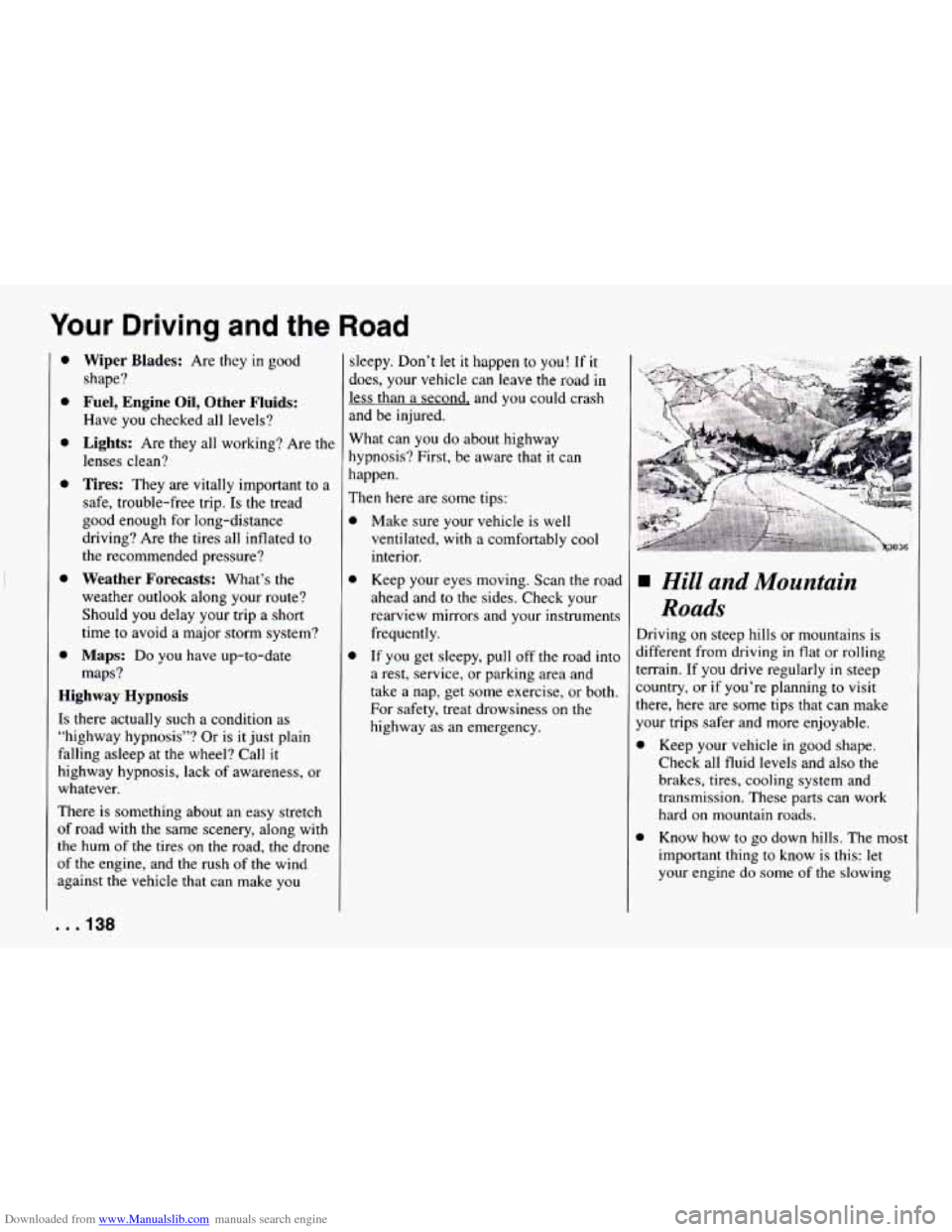
Downloaded from www.Manualslib.com manuals search engine Your Driving and the Road
e
e
Wiper Blades: Are they in good
shape?
Fuel, Engine Oil, Other Fluids:
Have you checked all levels?
Lights: Are they all working? Are the
lenses clean?
Tires: They are vitally important to a
safe, trouble-free trip. Is the tread
good enough for long-distance
driving? Are the tires all inflated to
the recommended pressure?
Weather Forecasts: What’s the
weather outlook along your route?
Should you delay your trip a short
time to avoid a major
storm system?
Maps: Do you have up-to-date
maps?
Highway Hypnosis
Is there actually such a condition as
“highway hypnosis”? Or is it just plain
falling asleep at the wheel? Call
it
highway hypnosis, lack of awareness, or
whatever.
There is something about an easy stretch
of road with the same scenery, along with
the hum of the tires
on the road, the drone
of the engine, and the rush
of the wind
against the vehicle that can make you sleepy. Don’t
let it happen to
you! If it
does, your vehicle can leave the road in
less than a second, and you could crash
and be injured.
What can you do about highway
hypnosis? First, be aware that
it can
happen.
Then here are some tips:
Make sure your vehicle is well
ventilated,
with a comfortably cool
interior.
Keep your eyes moving. Scan the road
ahead and
to the sides. Check your
rearview mirrors and your instruments
frequently.
If you get sleepy, pull
off the road into
a rest, service, or parking area and
take
a nap, get some exercise, or both.
For safety, treat drowsiness on the
highway as an emergency.
Hill and Mountain
Roads
Driving on steep hills or mountains is
different from driving
in flat or rolling
terrain.
If you drive regularly in steep
:ountry, or
if you’re planning to visit
there, here are some tips that can make
your trips safer and more enjoyable.
Keep your vehicle
in good shape.
Check all fluid levels and also the
brakes, tires, cooling system and
transmission. These parts can work
hard on mountain roads.
Know how to go down hills. The most
important thing
to know is this: let
your engine do some of the slowing
. . .13%
Page 147 of 292
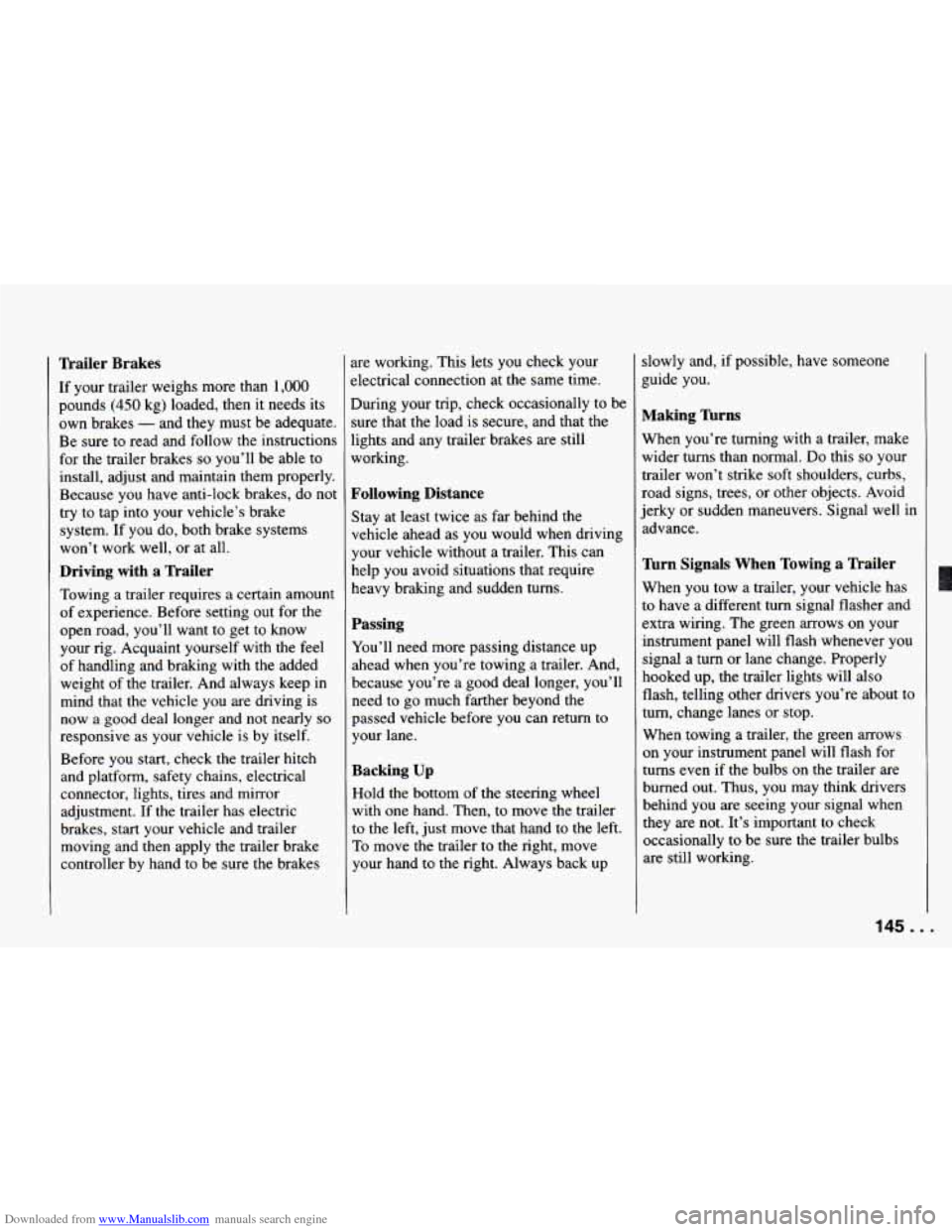
Downloaded from www.Manualslib.com manuals search engine Trailer Brakes
If your trailer weighs more than 1,000
pounds (450 kg) loaded, then it needs its
own brakes
- and they must be adequate.
Be sure to read and follow the instructions
for the trailer brakes
so you’ll be able to
install, adjust and maintain them properly.
Because you have anti-lock brakes, do not
try to tap into your vehicle’s brake
system. If you do, both brake systems
won’t work well, or at all.
Driving with a Trailer
Towing a trailer requires a certain amount
of experience. Before setting out for the
open road, you’ll want to get to know
your rig. Acquaint yourself with the feel
of handling and braking with the added
weight of the trailer. And always keep in
mind that the vehicle you are driving is
now
a good deal longer and not nearly so
responsive as your vehicle is by itself.
Before you start, check the trailer hitch
and platform, safety chains, electrical
connector, lights, tires and mirror
adjustment. If the trailer has electric
brakes, start your vehicle and trailer
moving and then apply the trailer brake
controller by hand to be sure
the brakes are working.
This lets
you check your
electrical connection at the same time.
During your trip, check occasionally to be sure that the load is secure, and that
the
lights and any trailer brakes are still
working.
Following Distance
Stay at least twice as far behind the
vehicle ahead as you would when driving
your vehicle without a trailer. This can
help you avoid situations that require
heavy braking and sudden turns.
Passing
You’ll need more passing distance up
ahead when you’re towing a trailer. And,
because you’re a good deal longer, you’ll need to go much farther beyond the
passed vehicle before you can return
to
your lane.
Backing Up
Hold the bottom of the steering wheel
with one hand. Then, to move the trailer
to the left, just move that hand to the left.
To move the trailer to the right, move
your hand to the right. Always back up slowly
and, if possible, have someone
guide you.
Making Turns
When you’re turning with a trailer, make
wider turns than normal.
Do this so your
trailer won’t strike soft shoulders, curbs,
road signs, trees, or other objects. Avoid
jerky or sudden maneuvers. Signal well in
advance.
Turn Signals When Towing a Trailer
When you tow a trailer, your vehicle has
to have a different turn signal flasher and
extra wiring. The green arrows on your
instrument panel will flash whenever you
signal a turn or lane change. Properly
hooked up, the trailer lights will also
flash, telling other drivers you’re about to
turn, change lanes or stop.
When towing a trailer, the green arrows
Dn your instrument panel will flash for
turns even if the bulbs on the trailer are
burned out. Thus, you may think drivers
behind you
are seeing your signal when
they are not. It’s important to check
occasionally to be sure the trailer bulbs
are still working.
145. I
Page 148 of 292

Downloaded from www.Manualslib.com manuals search engine Your Driving and the Road
Driving on Grades
Reduce speed and shift to a lower gear
before you start down a long or steep
downgrade. If you don’t shift down, you
might have to use your brakes
so much
that they would get hot and no longer
work well.
On a long uphill grade, shift down and
reduce your speed to around
45 mph
(70 kmh) to reduce the possibility of
engine and transmission overheating.
If you are towing a trailer and you
have an automatic transmission with
Overdrive, you may prefer to drive
in “D’
instead of Overdrive (or, as you need to,
a lower gear). Or,
if you have a manual
transmission with fifth (or sixth) gear
and you are towing a trailer, it’s better
not to use fifth (or sixth) gear. Just drive
in fourth gear (fifth gear if you have a
six-speed manual transmission) (or, as you
need to, a lower gear).
Parking on Hills
You really should not park your vehicle,
with a trailer attached, on a
hill. If
something goes wrong, your rig could
start to move. People can be injured, and both your vehicle and the trailer can be
damaged.
But if you
ever have to park your
rig on a
hill, here’s how to do it:
1. Apply your regular brakes, but don’t
shift into
“P’ (Park) yet, or into gear
for a manual transmission.
2. Have someone place chocks under the
3. When the wheel chocks are in place,
release the regular brakes until the
chocks absorb the load.
trailer wheels.
4. Reapply the
regular brakes. Then
apply your parking brake, and then
shift to
“P” (Park), or “R” (Reverse)
for a manual transmission.
5. Release the regular brakes.
When You Are Ready to Leave after
Parking on a Hill
1. Apply your regular brakes and hold
the pedal down while you:
Start your engine;
0 Shift into a gear; and
Release the parking brake.
2. Let up on the brake pedal.
3. Drive slowly until the trailer is clear
4. Stop ahd have someone pick up and
of the
chocks.
store the chocks.
Maintenance When Trailer Towing
Your vehicle will need service more often
when you’re pulling a trailer. See the
Maintenance Schedule for more on this.
Things that are especially important in
trailer operation are automatic
transmission fluid (don’t overfill), engine
oil, axle lubricant, belts, cooling system,
and brake adjustment. Each of these is
covered in this manual, and
the Index will
help you find them quickly. If you’re
trailering, it’s a good idea to review these
sections before you start your
trip.
Check periodically to see that all hitch
nuts and bolts are tight.
. . ,146
Page 151 of 292

Downloaded from www.Manualslib.com manuals search engine Jump Starting
If your battery has run down, you may
want to use another vehicle and some
jumper cables to start your Chevrolet. But
please follow the steps below to do it
safely. NOTICE:
Ignoring these steps could result in
costly damage to your vehicle that
wouldn’t be covered by your war-
ranty.
Trying to start your Chevrolet by
pushing or pulling
it could damage
your vehicle, even
if you have a
manual transmission. And if you
have an automatic transmission,
it
won’t start that way.
To Jump Start Your Chevrolet:
1. Check the other vehicle. It must have
a 12-volt battery with a negative
ground system.
NOTICE:
If the other system isn’t a 12-volt
system with a negative ground, both
vehicles can be damaged.
2. Get the vehicles close enough so the
jumper cables can reach, but be sure
the vehicles aren’t touching each other.
If they are,
it could cause a
ground connection you don’t want.
You wouldn’t be able to start your
Chevrolet, and the bad grounding
could damage the electrical systems.
3. Turn off the ignition on both vehicles.
Turn off all lights that aren’t needed,
and radios. This
will avoid sparks and
help save both batteries. And
it could
save your radio!
NOTICE:
If you leave your radio on, it could be’
badly damaged. The repairs wouldn’t
be covered
by your warranty.
4. Open the hoods and locate the
batteries.
149 ...
Page 152 of 292
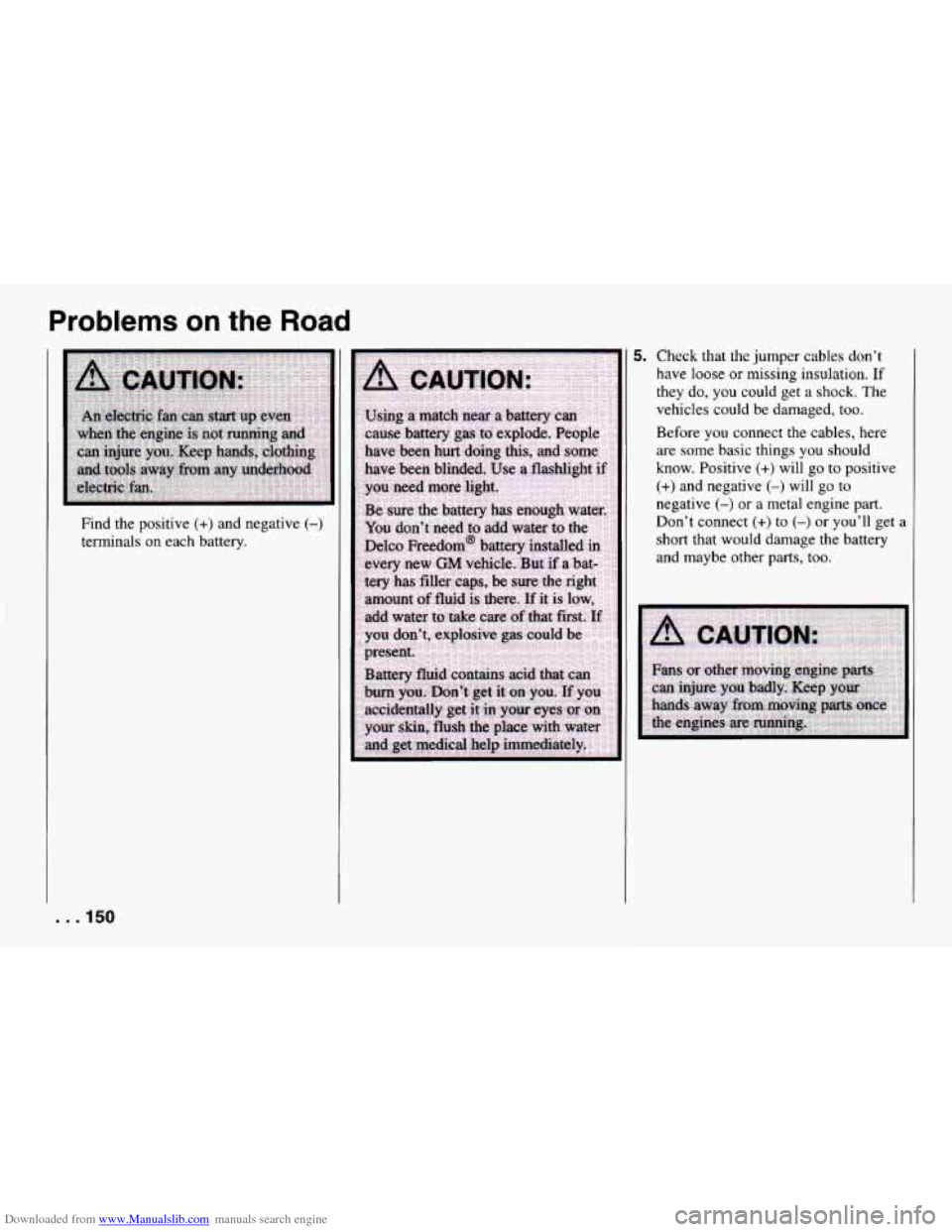
Downloaded from www.Manualslib.com manuals search engine Problems on the Road
Find the positive (+> and negative (-j
terminals on each battery.
5. Check that the jumper cables don’t
have loose or missing insulation. If
they do, you could get a shock. The
vehicles could be damaged, too.
Before you connect the cables, here
are some basic things you should
know. Positive (+) will go to positive
(+) and negative (-) will go to
negative
(-j or a metal engine part.
Don’t connect
(+) to (-) or you’ll get a
short that would damage the battery
and maybe other parts, too.
. . .150
Page 161 of 292
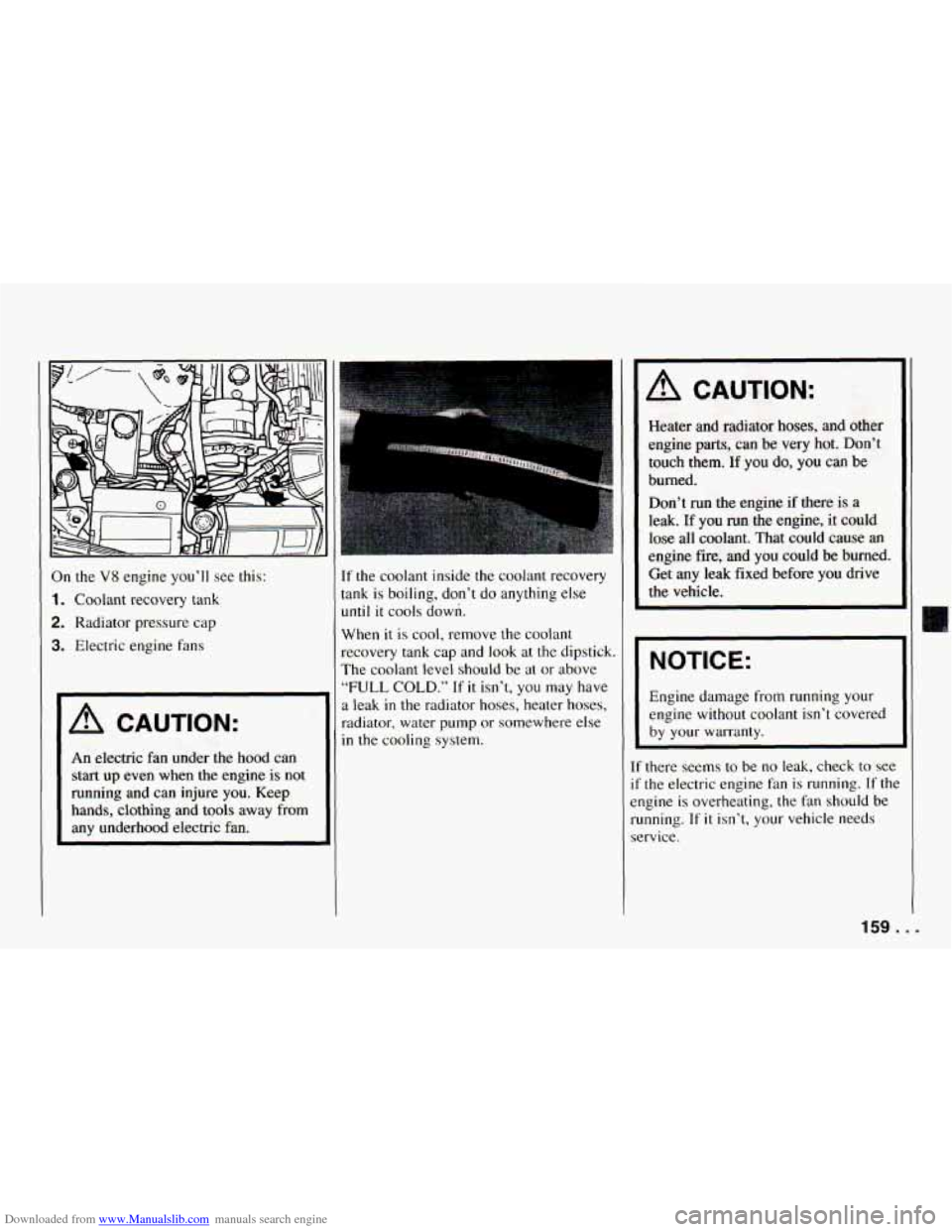
Downloaded from www.Manualslib.com manuals search engine On the V8 engine you’ll see this:
1. Coolant recovery tank
2. Radiator pressure cap
3. Electric engine fans
A CAUTION:
An electric fan under the hood can
start up even when the engine is not
running and can injure
you. Keep
hands, clothing and tools
away from
any underhood electric fan.
II
If the coolant inside the coolant recovery
tank is boiling, don’t do anything else
until it cools down.
When
it is cool, remove the coolant
recovery tank cap and look at
the dipstick.
The coolant level should be at or above
“FULL COLD.” If it isn’t, you may have
a leak
in the radiator hoses, heater hoses,
radiator,
water pump or somewhere else
in the cooling system.
A CAUTION:
Heater and radiator hoses, and other
engine parts, can be very hot. Don’t
touch them. If you do, you can be
burned.
Don’t
run the engine if there is a
leak. If you run the engine, it could
lose all coolant. That could
cause an
engine fire, and you could be burned.
Get any leak fixed before you drive
the vehicle.
NOTICE:
Engine damage from running your
engine without coolant isn’t covered
by your warranty. I
If there seems to be no leak, check to see
if the electric engine fan is running. If the
engine
is overheating, the fan should be
running.
If it isn’t, your vehicle needs
service.
159. I
Page 178 of 292
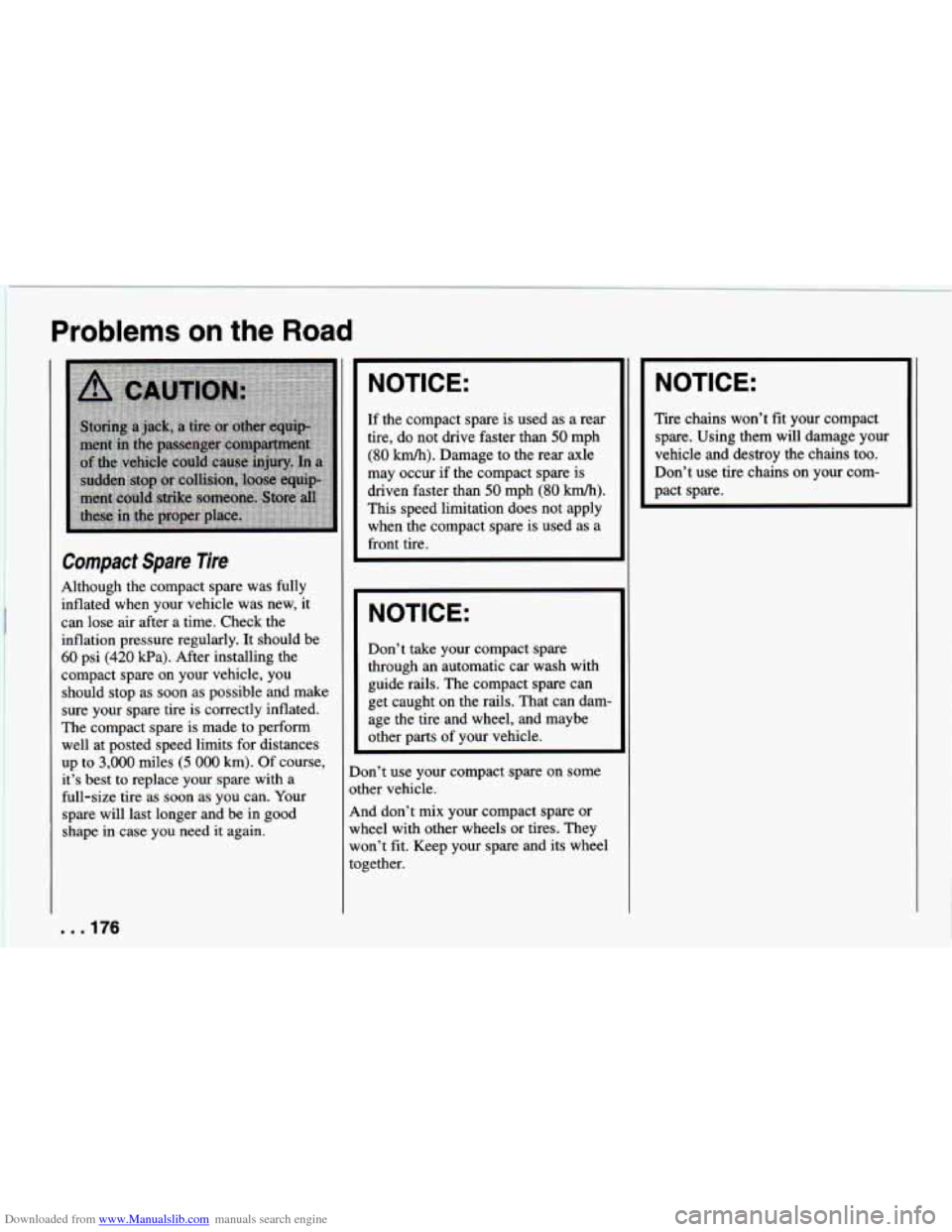
Downloaded from www.Manualslib.com manuals search engine Problems on the Road
Compact Spare Tire
Although the compact spare was fully
inflated when your vehicle was new, it
can lose air after a time. Check the inflation pressure regularly.
It should be
60 psi (420 Wa). After installing the
compact spare on your vehicle, you
should stop as soon as possible and make
sure your spare tire is correctly inflated.
The compact spare is made to perform
well at posted speed limits for distances
up to
3,000 miles (5 000 km). Of course,
it’s best to replace your spare with a
full-size tire as soon as you can. Your
spare will last longer and be in good
shape in case you need
it again.
NOTICE:
If the compact spare is used as a rear
tire, do not drive faster than
50 mph
(80 km/h). Damage to the rear axle
may occur if the compact spare is
driven faster than
50 mph (80 km/h).
This speed limitation does not apply
when the compact spare is used as a
front tire.
NOTICE:
Don’t take your compact spare
through an automatic car wash with
guide rails. The compact spare can
get caught on the rails. That can dam-
age the tire and wheel, and maybe
other parts of your vehicle.
Don’t use your compact spare on some
other vehicle.
And don’t mix your compact spare or
wheel with other wheels or tires. They
won’t fit. Keep your spare and its wheel
together.
NOTICE:
Tire chains won’t fit your compact
spare. Using them will damage your
vehicle and destroy the chains too.
Don’t use tire chains on your com-
pact spare.
. . .176
Page 181 of 292
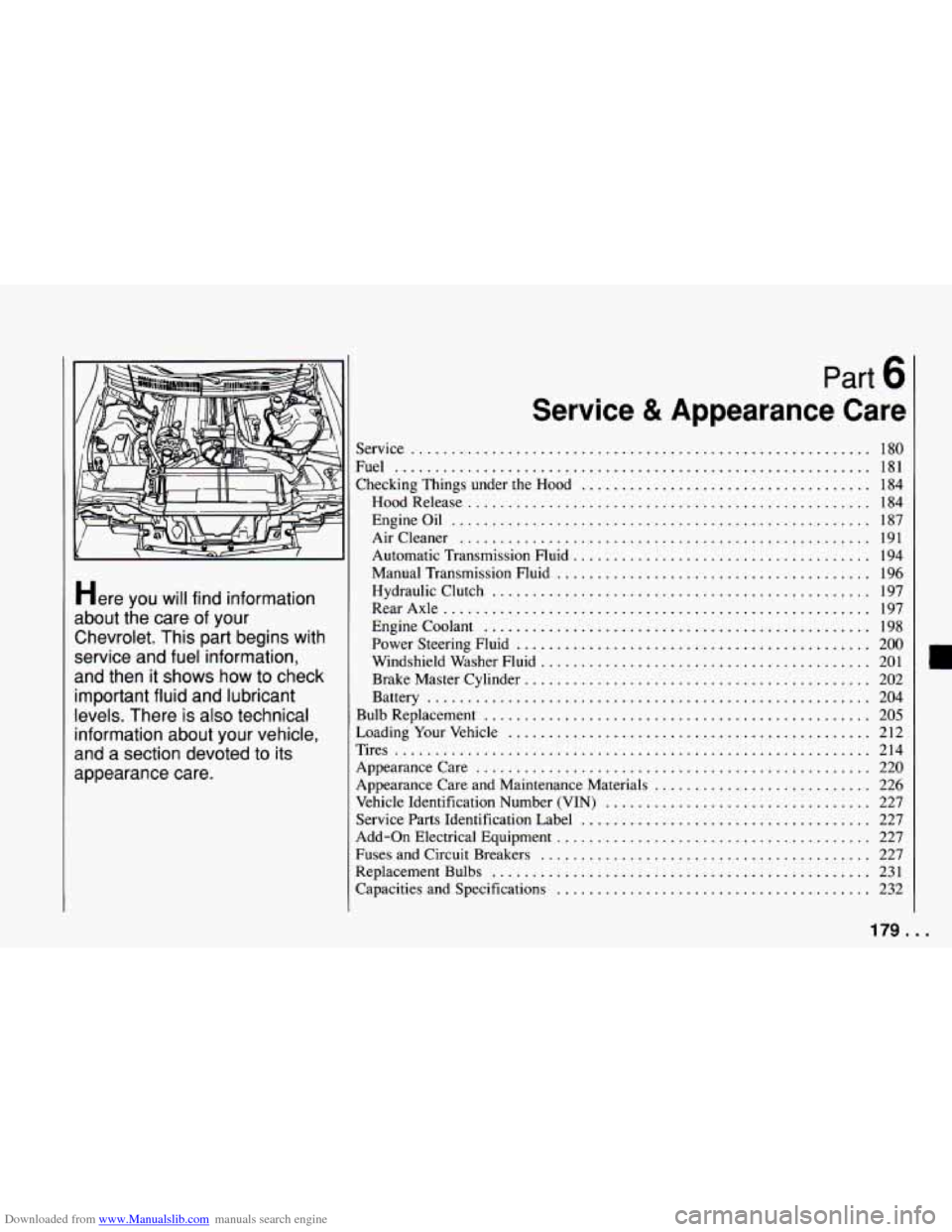
Downloaded from www.Manualslib.com manuals search engine Here you will find information
about the care of your
Chevrolet
. This part begins with
service and fuel information.
and then
it shows how to check
important fluid and lubricant
levels
. There is also technical
information about your vehicle.
and a section devoted to its
appearance care
.
Part 0
Service & Appearance Care
Service .........................................................
Fuel ...........................................................
Checking Things under the Hood ....................................
HoodRelease ..................................................
EngineOil ....................................................
Aircleaner ...................................................
Automatic Transmission Fluid .....................................
Manual Transmission Fluid .......................................
Hydraulic Clutch ...............................................
RearAxle .....................................................
Enginecoolant ................................................
Power Steering Fluid ............................................
Windshield Washer Fluid .........................................
Brake Master Cylinder ...........................................
Battery .......................................................
Bulb Replacement ................................................
LoadingYourVehicle .............................................
Tires ...........................................................
Appearancecare .................................................
Appearance Care and Maintenance Materials ...........................
Vehicle Identification Number (VIN) .................................
Service Parts Identification Label ....................................
Add-on Electrical Equipment .......................................
Fuses and Circuit Breakers .........................................
Replacement Bulbs ...............................................
Capacities and Specifications .......................................
180
181
184
184
187 191
194
196
197
197
198
200
201
202
204
205
212
214
220
226
227
227
227
227
231
232
179 ...
Page 184 of 292
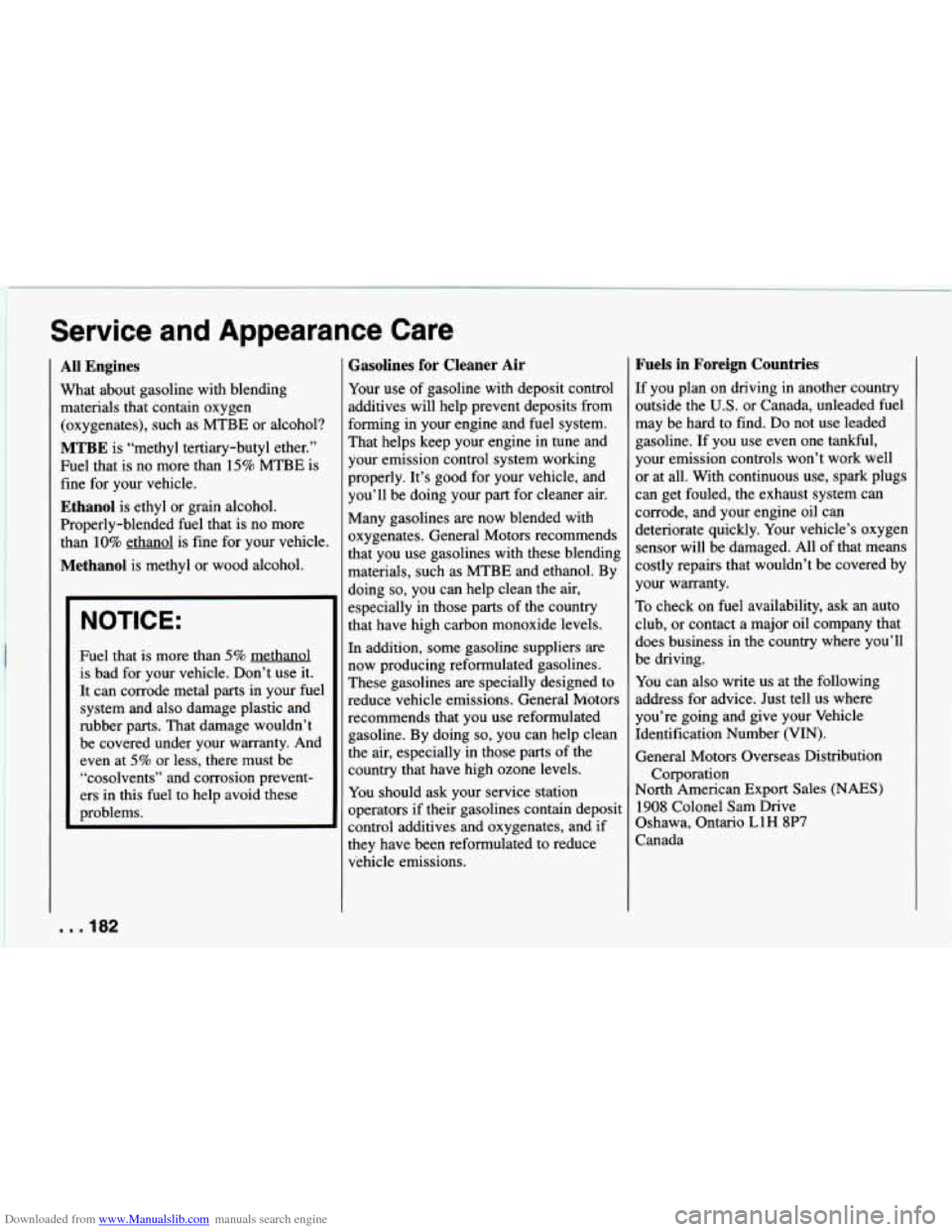
Downloaded from www.Manualslib.com manuals search engine e
Service and Appearance Care
1
All Engines
What about gasoline with blending
materials that contain oxygen
(oxygenates), such as MTBE or alcohol?
MTBE is “methyl tertiary-butyl ether.”
Fuel that is no more than
15% MTBE is
fine for your vehicle.
Ethanol is ethyl or grain alcohol.
Properly-blended fuel that is no more
than
10% ethanol is fine for your vehicle
Methanol is methyl or wood alcohol.
NOTICE:
Fuel that is more than 5% methanol
is bad for your vehicle. Don’t use it.
It can corrode metal parts in your fuel
system and also damage plastic and
rubber parts. That damage wouldn’t
be covered under your warranty. And
even at
5% or less, there must be
“cosolvents” and corrosion prevent-
ers in this fuel to help avoid these
problems.
Gasolines for Cleaner Air
Your use of gasoline with deposit control
additives will help prevent deposits from
forming in your engine and fuel system.
That helps keep your engine in tune and
your emission control system working
properly. It’s good for your vehicle, and
you’ll be doing your part for cleaner air.
Many gasolines are now blended with
oxygenates. General Motors recommends
that you use gasolines with these blending
materials, such as MTBE and ethanol. By
doing
so, you can help clean the air,
especially in those parts of the country
that have high carbon monoxide levels.
In addition, some gasoline suppliers are
now producing reformulated gasolines.
These gasolines are specially designed to
reduce vehicle emissions. General Motors
recommends that you use reformulated
zasoline. By doing
so, you can help clean
:he air, especially in those parts of the
:ountry that have high ozone levels.
You should ask your service station
lperators if their gasolines contain deposit
:ontrol additives and oxygenates, and
if
:hey have been reformulated to reduce
iehicle emissions.
Fuels in Foreign Countries
If you plan on driving in another country
outside the
U.S. or Canada, unleaded fuel
may be hard to find.
Do not use leaded
gasoline. If
you use even one tankful,
your emission controls won’t work well
or at all. With continuous use, spark plugs
can get fouled, the exhaust system can
corrode, and your engine oil can
deteriorate quickly. Your vehicle’s oxygen
sensor will be damaged. All
of that means
costly repairs that wouldn’t be covered by
your warranty.
To check on fuel availability, ask an auto
club, or contact a major oil company that
does business in the country where you’ll
be driving.
You can also write
us at the following
address for advice. Just tell
us where
you’re going and give your Vehicle
Identification Number (VIN).
Seneral Motors Overseas Distribution
Vorth American Export Sales (NAES)
1908 Colonel Sam Drive
Dshawa, Ontario
L1H 8P7
Zanada Corporation
. . .I82